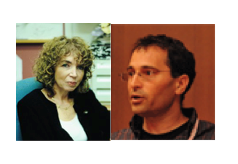Weizmann identifie la signature du vieillissement dans le cerveau : c’est « l’âge immunologique » du cerveau qui compte

[:fr]Comment le cerveau vieillit – voilà une question qui n’est pas encore résolue, en partie parce qu’en général cet organe n’a pas de contact direct avec les autres systèmes du corps, y compris le système sanguin et le système immunitaire. Des chercheurs de l’Institut Weizmann, la professeure Michal Schwartz, du département de Neurobiologie, et le docteur Ido Amit, du département d’Immunologie, ont découvert la preuve d’une « signature » particulière qui pourrait être le « chaînon manquant » entre le déclin cognitif et le vieillissement. Les chercheurs pensent qu’à l’avenir cette découverte pourrait mener à des traitements capables de ralentir ou d’inverser le déclin cognitif chez les personnes âgées.
Il y a une dizaine d’années encore, selon un dogme scientifique, on considérait que la barrière sang-cerveau empêchait les cellules immunitaires apportées par le sang d’attaquer et de détruire le tissu cérébral. Mais une longue série de recherches a amené le groupe de la docteure Schwartz à montrer que le système immunitaire joue en fait un rôle important aussi bien dans la guérison du cerveau après un traumatisme que dans le maintien du fonctionnement normal du cerveau. Le groupe a découvert que l’interaction du cerveau avec le système immunitaire se produit à travers une barrière qui est en fait une interface unique à l’intérieur du cerveau.
Cette interface, connue sous le nom de « plexus choroïde » se trouve dans chacun des quatre ventricules du cerveau, et sépare le sang du liquide cérébrospinal. La docteure Schwartz explique : « Le plexus choroïde agit comme une télécommande permettant au système immunitaire d’intervenir dans l’activité du cerveau. Les signaux biochimiques de ‘danger’ envoyés par le cerveau sont détectés à travers cette interface ; à leur tour, les cellules immunitaires transportées par le sang interviennent en communiquant avec le plexus choroïde. Ce dialogue croisé est important pour préserver les capacités cognitives et promouvoir la génération de nouvelles cellules cérébrales. » Cette découverte a mené la professeure Schwartz et son groupe à l’idée qu’un déclin cognitif au fil des ans pourrait être lié non seulement à « l’âge chronologique » mais aussi à « l’âge immunologique » d’une personne, ce qui signifie que des changements dans le fonctionnement du système immunitaire pourraient avec le temps contribuer à des changements dans le fonctionnement du cerveau, sans que ce soit nécessairement en phase avec l’âge des personnes.
Pour tester cette théorie, la professeure Schwartz et les doctorants Kuti Baruch et Aleksandra Deczkowska ont fait équipe avec le docteur Ido Amit et son groupe de recherche dans le département d’Immunologie. Les chercheurs ont utilisé une technologie de séquençage de la nouvelle génération pour cartographier les changements de l’expression génique dans onze organes différents, parmi lesquels le plexus choroïde, chez des souris jeunes et chez des souris âgées, pour identifier et comparer les voies impliquées dans le processus de vieillissement. C’est ainsi qu’ils ont identifié une « signature du vieillissement » tout à fait particulière qui existe seulement dans le plexus choroïde, et qui ne se trouve dans aucun autre organe. Ils ont découvert que l’un des éléments les plus importants de cette signature est l’interféron bêta, une protéine normalement produite par le corps pour lutter contre les infections virales. Cette protéine semble avoir un effet nocif sur le cerveau : lorsque les chercheurs injectent un anticorps qui bloque l’activité de l’interféron bêta dans le liquide cérébrospinal des souris âgées, leurs capacités cognitives sont rétablies, de même que leur capacité de former de nouvelles cellules cérébrales. Les chercheurs ont aussi réussi à identifier cette signature unique dans le cerveau de personnes âgées. Ils espèrent que cette découverte pourra à l’avenir aider à empêcher ou à inverser le déclin cognitif à un âge avancé, en trouvant des moyens de rajeunir « l’âge immunologique » du cerveau.
Publication dans la revue Science
La recherche du docteur Ido Amit est financée par : M.D. Moross Institute for Cancer Research ; J&R Center for Scientific Research ; Jeanne and Joseph Nissim Foundation for Life Sciences Research ; Abramson Family Center for Young Scientists; Wolfson Family Charitable Trust ; Abisch Frenkel Foundation for the Promotion of Life Sciences ; Leona M. and Harry B. Helmsley Charitable Trust ; Sam Revusky, Canada ; Florence Blau, Morris Blau and Rose Peterson Fund ; la succession d’Ernst et Anni Deutsch ; la succession d’Irwin Mandel ; la succession de David Levinson. Le docteur Amit est titulaire de la Alan and Laraine Fischer Career Development Chair.
[:en]
Prof. Michal Schwartz’s research is supported by the Jeanne and Joseph Nissim Foundation for Life Sciences Research; the Adelis Foundation; the European Research Council; Nathan and Dora Oks, France; and Hilda Namm, Larkspur, CA. Prof. Schwartz is the incumbent of the Maurice and Ilse Katz Professorial Chair of Neuroimmunology. [:]






